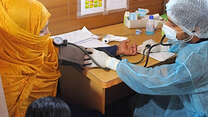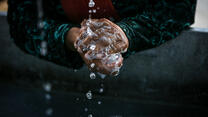The world’s most vulnerable countries could see up to 1 billion COVID-19 infections and 3.2 million deaths unless we act now, warns the International Rescue Committee (IRC).
Learn why these alarming estimates are conservative at best, and find out what can be done to prevent the worst from happening:
A wake-up call
Based on potential response scenarios, the IRC estimates between 500 million and 1 billion coronavirus infections, leading to between 1.7 to 3.2 million deaths, in 34 countries where we work—including war zones like Afghanistan, Syria and Yemen.
Our analysis shows the world could see up to 1 billion infections and 3.2 million deaths due to #COVID19 in 34 crisis-affected countries served by the IRC, including warzones like Afghanistan, Syria, and Yemen.
— IRC - International Rescue Committee (@RESCUEorg) April 28, 2020
The time to act is now. Learn more: https://t.co/PjKMbiqXSipic.twitter.com/N3zUP00qSg
“These numbers should serve as a wake-up call,” says IRC president and CEO David Miliband. “The full, devastating and disproportionate weight of this pandemic has yet to be felt in the world’s most fragile and war-torn countries.”
A small window of time to act
Without swift action in the coming weeks to mitigate the spread of COVID-19 before it overwhelms fragile countries, we could see deaths in the tens of millions. Urgent funding is needed for frontline responses—this includes ensuring that countries have consistent access to personal protective equipment and handwashing stations, and that they can test and isolate all suspected coronavirus cases.
“We are still in the critical window of time to mount a robust preventative response to the early stages of COVID-19 in many of these countries and prevent a further perpetuation of this epidemic globally,” says Miliband.
Social distancing may not be possible
Overcrowded refugee camps in countries included in the analysis, such as Syria, Greece and Bangladesh, are some of the most densely-populated places in the world—up to 8.5 times more densely populated than the Diamond Princes cruise ship, where COVID-19 spread up to four times faster than in Wuhan, China at the start of the outbreak.
View this post on InstagramA post shared by International Rescue Committee (@rescueorg) on
As the IRC has previously reported, extreme social distancing isn’t sustainable in refugee camps and war zones. We need to find ways to tailor the COVID-19 response to local conditions.
Inside our analysis
The preliminary estimates compiled by the IRC are based on epidemiological modelling and data produced by Imperial College London and the World Health Organization. This model takes into account the age structure, household size and social contact patterns of different countries, as well as mortality patterns from the early outbreak in China.
Scientists are still studying what drives the pandemic in lower-income contexts, including factors such as population health risks, which may drive infection rates up, or others, such as younger population age structure, which may drive mortality rates down. But the data we found was sufficient to spark significant alarm on the international trajectory of COVID-19.

A conservative estimate
Limitations of the current data suggest that the estimates for fragile countries may be conservative at best:
The data presumes levels of medical care available in China (the source of the best available COVID-19 mortality figures) would be available elsewhere.
As the IRC has previously warned, fragile states have nowhere near the health care capacity of China. In Venezuela alone, the longstanding economic and humanitarian crisis has forced more than half of doctors to leave the country and left 90% of hospitals short on medicine and critical supplies. In addition, as we’ve seen, refugee camps are among the world’s most densely populated places, making it impossible for people to follow extreme social distancing guidelines used elsewhere.
Mortality figures do not account for excess deaths caused by pre-existing health issues such as malnutrition or by economic and political instability.
While strict lockdowns and social distancing will save lives in wealthier nations during the COVID-19 pandemic, these same measures risk harming people living in crisis areas. Without social safety nets, the shut-down of businesses and loss of income may leave people in these countries that are facing a "double emergency" more vulnerable to hunger, poverty and domestic violence.
Restrictions on movement and disruptions to supplies due to COVID-19 are already impacting the ability of agencies like the IRC to deliver aid to people in need.
South Sudan, a country where almost 65% of the population already relies on humanitarian assistance, may face famine as a result of restricted movement, economic instability, reduction in agricultural labor, and pre-existing high levels of malnutrition and chronic food insecurity.

What have we learned about how to fight COVID-19 in fragile states?
Applying a “one-size-fits-all” approach based on measures taken in countries hit first by COVID-19 is unrealistic and potentially counterproductive. The IRC has released a new report, One size does not fit all: mitigating COVID-19 in humanitarian settings, that details the risks and possible solutions required to combat the coronavirus in crisis areas and avoid exacerbating humanitarian suffering.
“Without immediate international action that supports the needs and unique challenges faced by people in these countries in the face of COVID-19,” says David Miliband, “the consequence will be the loss of life and livelihood on an appalling scale.”
What is the IRC doing to help?
IRC teams on the ground are providing essential health care services, equipping aid workers with protective gear and delivering hygiene kits to people in refugee camps and crisis zones.
The IRC's response strategy aims to mitigate the spread of COVID-19 and treat patients while focusing on meeting the other health and economic needs of the people we serve, and expanding our protection services for women and girls. As part of this effort, our research and innovation team is helping create cost-effective COVID-19 solutions tailored for the crisis zones in which we work.
Learn more about our coronavirus response.
How can I help?
The IRC has launched a $30 million appeal to help us mitigate the spread of coronavirus among the world’s most vulnerable populations, protect our staff, and ensure the continuation of our lifesaving programming.



